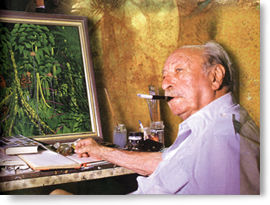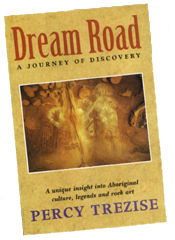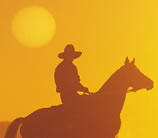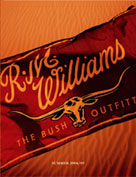OUTBACK PEOPLE
The guru of rock art
Story and photos: Barbara and Bruce Duncan
 An
overfull roll-your-own dangles precariously from his ever-present cigarette
holder. He stretches back in his chair and expounds.
An
overfull roll-your-own dangles precariously from his ever-present cigarette
holder. He stretches back in his chair and expounds.
Percy Trezise, acclaimed painter and rock art historian, is discussing his second favourite subject. "A dingo didn't take Azaria Chamberlain," he says with authority, "it was a thylacine, a marsupial wolf - what we call a Tasmanian Tiger.
The tigers are much bigger and stronger and much stealthier than dingoes. They're elusive. They only come out on starlit nights to hunt. Never in moonlight. That's why people believe they're extinct. Very few people have seen them, but I have."
The last captive thylacine died in Hobart Zoo in 1934 and the species was declared protected in 1938, after which there have been no authenticated sightings. But Percy Trezise and other outback bushman claim the breed is alive and flourishing in North Queensland and in the Northern Territory.
They attribute a large number of sheep and calf killings to the marsupial wolf, rather than the invariably blamed dingo, and claim there is a thylacine gene pool in Daintree wilderness. Percy has plaster casts of the foot-prints of a native dog that are far too big to be a dingo's.
 He
has a collection of droppings that clearly indicate the dog is omnivorous,
like the dingo. This negates the possibility that they prints are those
of a large domestic dog that has taken to the wild.
He
has a collection of droppings that clearly indicate the dog is omnivorous,
like the dingo. This negates the possibility that they prints are those
of a large domestic dog that has taken to the wild.
Percy Trezise is a man of decided opinions, and still, at 77, a man of action. He has produced thousands of paintings.
One of his triptychs hangs in Parliament House in Canberra, and another in Sydney's Westmead Children's Hospital. A third triptych, Battle Camp, is displayed in the Quinkan Hotel at Laura - west of Cooktown - which Percy owns. He has written 24 children's books on Aboriginal rock art.
The children's books are used in every school in Australia, and one of
the history books, Dream Road, published in 1998, was declared in Europe
as one of the 10 most notable books of that year. ![]()
Full story: Issue 12, August - September, 2000


